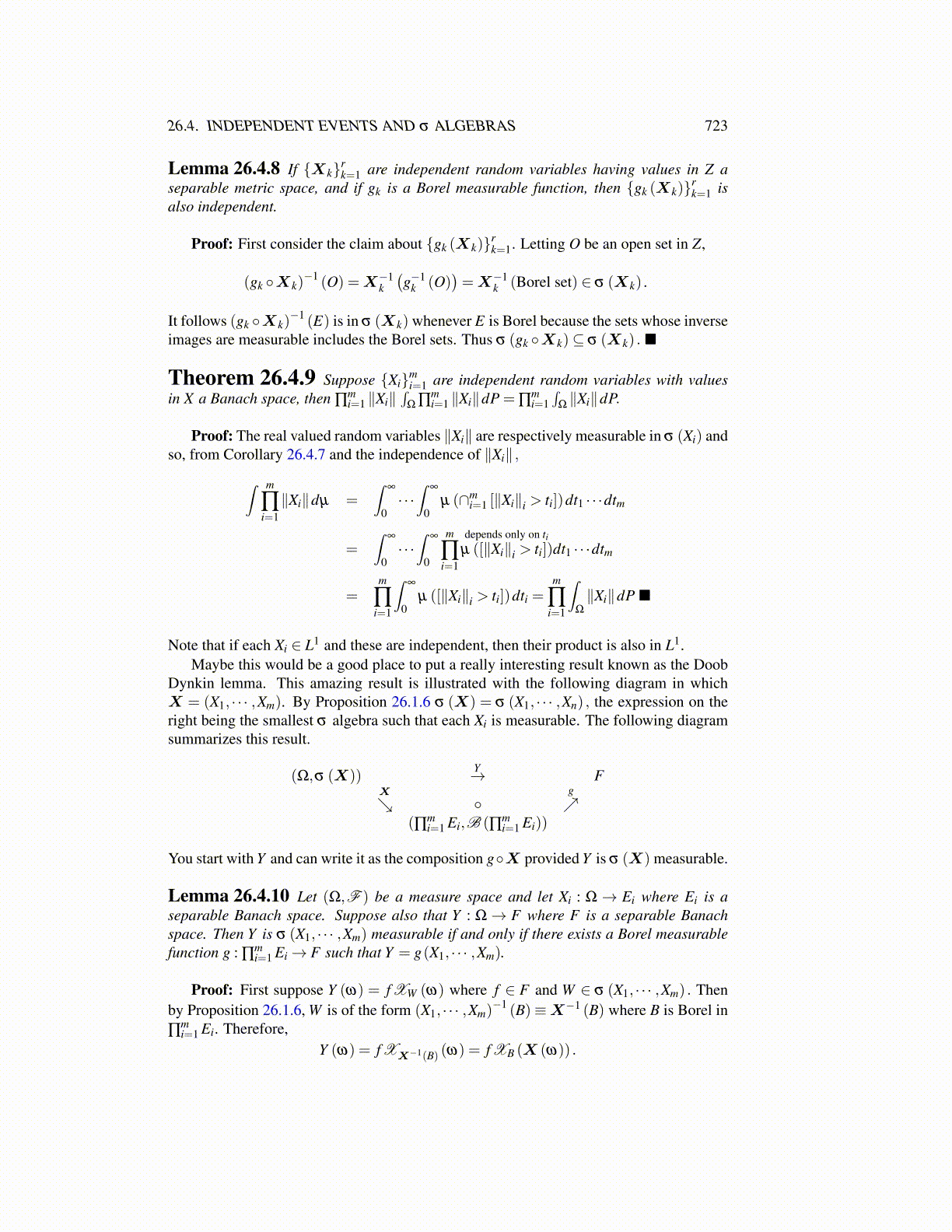
26.4. INDEPENDENT EVENTS AND σ ALGEBRAS 723
Lemma 26.4.8 If {Xk}rk=1 are independent random variables having values in Z a
separable metric space, and if gk is a Borel measurable function, then {gk (Xk)}rk=1 is
also independent.
Proof: First consider the claim about {gk (Xk)}rk=1. Letting O be an open set in Z,
(gk ◦Xk)−1 (O) =X−1
k
(g−1
k (O))=X−1
k (Borel set) ∈ σ (Xk) .
It follows (gk ◦Xk)−1 (E) is in σ (Xk) whenever E is Borel because the sets whose inverse
images are measurable includes the Borel sets. Thus σ (gk ◦Xk)⊆ σ (Xk) . ■
Theorem 26.4.9 Suppose {Xi}mi=1 are independent random variables with values
in X a Banach space, then ∏mi=1 ∥Xi∥
∫Ω ∏
mi=1 ∥Xi∥dP = ∏
mi=1∫
Ω∥Xi∥dP.
Proof: The real valued random variables ∥Xi∥ are respectively measurable in σ (Xi) andso, from Corollary 26.4.7 and the independence of ∥Xi∥ ,∫ m
∏i=1∥Xi∥dµ =
∫∞
0· · ·∫
∞
0µ (∩m
i=1 [∥Xi∥i > ti])dt1 · · ·dtm
=∫
∞
0· · ·∫
∞
0
m
∏i=1
depends only on tiµ ([∥Xi∥i > ti])dt1 · · ·dtm
=m
∏i=1
∫∞
0µ ([∥Xi∥i > ti])dti =
m
∏i=1
∫Ω
∥Xi∥dP ■
Note that if each Xi ∈ L1 and these are independent, then their product is also in L1.Maybe this would be a good place to put a really interesting result known as the Doob
Dynkin lemma. This amazing result is illustrated with the following diagram in whichX = (X1, · · · ,Xm). By Proposition 26.1.6 σ (X) = σ (X1, · · · ,Xn) , the expression on theright being the smallest σ algebra such that each Xi is measurable. The following diagramsummarizes this result.
(Ω,σ (X))Y→ F
X
↘ ◦g↗
(∏mi=1 Ei,B (∏m
i=1 Ei))
You start with Y and can write it as the composition g◦X provided Y is σ (X) measurable.
Lemma 26.4.10 Let (Ω,F ) be a measure space and let Xi : Ω→ Ei where Ei is aseparable Banach space. Suppose also that Y : Ω→ F where F is a separable Banachspace. Then Y is σ (X1, · · · ,Xm) measurable if and only if there exists a Borel measurablefunction g : ∏
mi=1 Ei→ F such that Y = g(X1, · · · ,Xm).
Proof: First suppose Y (ω) = f XW (ω) where f ∈ F and W ∈ σ (X1, · · · ,Xm) . Thenby Proposition 26.1.6, W is of the form (X1, · · · ,Xm)
−1 (B)≡X−1 (B) where B is Borel in∏
mi=1 Ei. Therefore,
Y (ω) = f XX−1(B) (ω) = f XB (X (ω)) .